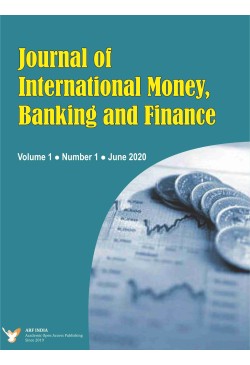
Journal of International Money, Banking and Finance
Frequency :Bi-Annual
ISSN :2582-7650
Peer Reviewed Journal
The kernel of this research is to re-examine the implications of the sizereturns characteristics of Nigerian stock market in the face of the coronavirus pandemic. The study is based on secondary data, obtained on weekly basis, from the websites of the Nigerian Stock Exchange and the Nigeria Centre for Disease Control. In a period of 33 weeks, stretching from 29th February, 2020 to 18th October, 2020, this study explores the dynamics of stock market size, coronavirus and stock returns in Nigeria using Autoregressive Distributed Lag (ARDL) model. Empirical findings indicate that in the short run, stock market size has positive significant effect on stock returns in Nigeria whereas in the long run, the position is reversed to negative and statistically significant. However, coronavirus does not have a significant influence on stock returns in Nigeria in the study period. It can therefore be concluded that coronavirus disease does not distort the negative connection between stock market size and stock market returns in Nigeria as stated by stock market size-returns hypothesis. It is therefore recommended that policies that ensure positivity of market size-returns nexus in the short-run should be elongated to the long-run to reverse the negative long-run implications of stock market size on stock returns in Nigeria.
Key words: Stock market returns, Stockmarket size, Bounds Testing, Coronavirus, MarketCapitalisation.
JEL Classification: E22, G11, I10
Financial ratios have been a key tool of financial analysis in the corporate world for a very long time. However, the adjustment of financial indicators to the evaluation of Municipalities is relatively recent. In the present work, the critical presentation of the financial situation of the Municipalities of Karpathos, Patmos and Kalymnos, which are the three Municipalities of the South Aegean Region of Greece, took place, in order to determine whether these Municipalities were affected by the economic crisis, in terms of financial strength. The analysis shows that there are significant differences in the general liquidity ratios between the three Municipalities, with the Municipality of Patmos showing higher prices and the Municipality of Kalymnos the lowest. However, these prices do not seem to be affected by the economic crisis and in fact, from 2012 onwards there seems to be a significant improvement, especially in the Municipalities of Patmos and Kalymnos. The dependency index for all three Municipalities remains stable over time and is at levels that do not justify the assumption that the dependence of Municipalities on Central Government has increased or decreased.
Key words: financial crisis, State and Local Government, financial ratios, financial health
JEL Classification: JEL: H76, M48, R51
Economic liberalization, financial inclusion and financial innovation have fueled not only the growth of banking institutions but also non-banking financial institutions called shadow banking. Shadow banks are rendering easy access to financial services and credit availability and supporting Nepalese economy. The study uses exploratory and descriptive research design. The study found that nonbanking sector has occupied 12.7 percentages of the total assets and liability structure of the Nepalese financial system in mid-January 2019 which was 11.5 percentages in mid-June 2018. Shadow banking, however, can raise the systemic risk via reinforcing interconnectedness between financial institutions. This study reviews the national and international financial agencies’ policies that Nepal Rastra Bank (NRB) can refer to and has already responded through various policies for the regulatory framework. As a central bank of Nepal, NRB is in the avenue of setting up the prudential mechanism for the stronger regulation to prevent excessive leverage, deregulation and maturity mismatch of shadow banking in order to achieve financial stability in Nepal.
Key words: Shadow banking, regulation, supervision, central bank and financial stability.
JEL Classification: G21, G22, G23, G28.